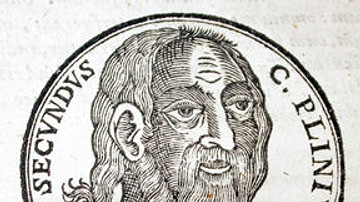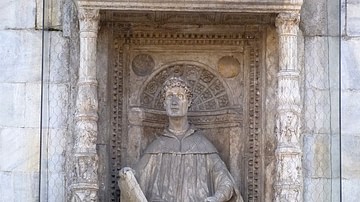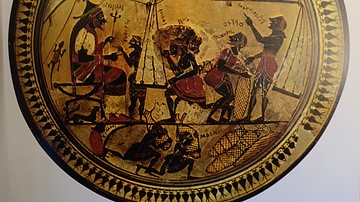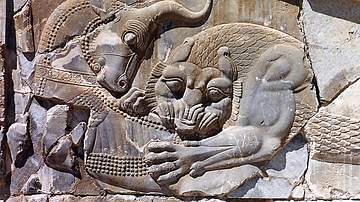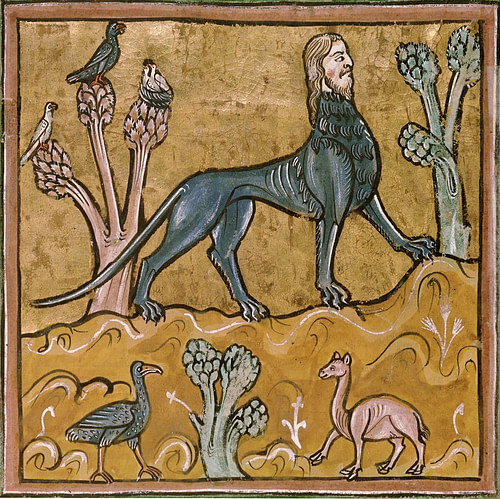
The manticore, derived from the Early Middle Persian merthykhuwar or martiora, meaning "man-eater" (also known as a mantichora or a martichore), is a fearsome hybrid creature found in classical and medieval literature. It has the body of a lion, the head of a man and a scorpion tail that can shoot poisonous darts.
The manticore is one of the most bizarre and ferocious creatures depicted throughout classical and medieval bestiaries. Its roots can be traced back to India and Persia (modern-day Iran). The myth of the manticore spreads over several centuries and is mentioned most famously by Ctesias (5th century BCE), Pliny the Elder (23-79 CE) and Pausanias (c. 115 to c. 180 CE).
Appearance & Characteristics
The earliest known mention of the manticore comes from the Greek historian and physician Ctesias in his Indica (written in the 5th century BCE). Although the Indica is now lost to time, fragments of Ctesias' work exist in other authors' writings, and we have a clear description of the manticore. According to Pliny the Elder in his Natural History:
Ctesias writes that amongst these same men there is found an animal called the Mantichora which has three rows of teeth like a comb, the face and ears of a human, and bluish eyes. It is red in colour with the body of a lion and a tail with stingers like a scorpion. Its voice is as if the sounds of the pipe were mixed with a trumpet and it is a creature of great speed which avidly goes after human flesh. (8.75)
Pliny's account of the manticore influenced later writers. He seemed to give the monster a basis in reality as he was considered the expert on strange and marvellous creatures for hundreds of years.
The morphology of the manticore was believed to have developed from its environment – the rugged and barren landscape of the Indian and Middle Eastern deserts. It needed to be fierce and to have weapons at its disposal to be able to catch its prey and prevent being caught by predators. Initially preying on animals like pigs and mountain goats, the manticore began to be lured to villages by the livestock it was hunting and inevitably began to attack and feed on humans, establishing the lore of the man-eating manticore.
The manticore would famously leave no trace of its prey behind. It could attack a human up close with its sharp claws or shoot poisonous darts from its scorpion tail from a safe distance. When it unleashes the poisonous darts from its tail, the tail either bends back or stretches out. Roman writer Aelian (175-235 CE) states that "whatever it hits, it kills, with the exception of elephants" (Characteristics of Animals, 4.21). The poisonous stingers are described as being thick as a rope and one foot (30 cm) in length. Once a stinger has been discharged, another one grows in its place.
Manticores did not just satisfy their appetites by killing one human but would chase after multiple people at a time, taking great pleasure in the hunt. Its favourite way to lure and hunt prey was to hide its body in the long grass, so from a distance, all humans would be able to see would be a human head. Deceived by this, humans would get close to the manticore, and before they knew what was happening, they would be attacked and killed. This showed how cunning and clever the manticore was. Although humans were undoubtedly a manticore's preferred prey, they would also regularly hunt the animal kingdom, except for lions which they could never overpower.
In order to stop the manticores' aggressive nature, the Indians would hunt baby manticores and smash their tails with rocks to prevent them from growing and shooting their poisonous darts and thus taking away their ability to harm humans from a great distance. Manticores lived in burrows deep under the ground where they could hide from their prey and avoid being seen by humans.
Origins & Possible Explanations
The manticore was thought to have its origins in ancient India and Persia. Some sources state that it originated in ancient Persian mythology, while others claim that it was an Indian creature. According to Aelian in his Characteristics of Animals, "Ctesias claims to have seen one such creature which was brought to the Persian king as a gift" (4.21). Other writers back up this claim, stating that although Ctesias first saw the creature in Persia, it had originally come from India. It is, therefore, perhaps correct to say that it originated in Persian literature but was portrayed as a creature from Indian mythology.
Despite Pliny the Elder having accepted the manticore as a reality, or so it seemed in his Natural History, some of his fellow writers were not shy about dismissing the creature as pure nonsense and suggesting that it was another animal that Ctesias saw. For example, in his Description of Greece, the Greek historian and geographer Pausanias compares the manticore to a tiger and attempts to give a rational explanation for its origins:
In the account given by Ctesias, there is a beast in India called the martichora by the Indians and the 'man-eater' by the Greeks which I take to refer to the tiger. It has three rows of teeth on each jaw and a stinger on the tip of its tail. It defends itself with these stingers in close combat and discharges them when fighting at a distance like a bowman's arrow. I think excessive fear for the beast has led the Indians to receive a false account from each other. (9.21.4)
In the 2nd century CE, Greek writer Flavius Philostratus (c. 170-245 CE) claimed that the manticore was a "tall story" (Life of Apollonius of Tyana, 3.45).
Aristotle (384-322 BCE), who, along with Pliny the Elder, was also considered a great authority on the known world during the Middle Ages, denied that hybrid creatures existed. He noted that it would be impossible for animals that were so different to procreate with one another successfully. However, this did not deter the rise in popularity of hybrid monsters appearing in art and literature.
In the 13th century, a scholastic of Paris, Bartholomew Anglicus, compared the manticore to a bear and placed its location in India in his De proprietatibus rerum (On the Order of Things). Italian scholar, Brunetto Latini, classified it with other carnivorous creatures like the wolf and the hyena in his encyclopedia Li Livres dou Trésor (Book of Treasures).

The prominent teeth and strange call of the manticore caused some classical and early modern writers to compare it to the African hyena. While its long tail and speed made others think it was more like a cheetah. The fearsome nature of the creature and its love for human flesh may have simply represented the fear of that which was unfamiliar and foreign.
Depictions
During the Middle Ages, the manticore was a favourite feature of bestiaries. They would often appear as a decoration in medieval cathedrals, symbolising the doom-predicting Hebrew prophet Jeremiah. In the 16th century, manticores were sometimes featured in heraldry; however, this trend did not last long as it was thought that they represented evil, an idea that was widespread during the medieval period.
Depictions of the manticore can be found on the Hereford Mappa Mundi (a medieval map of the known world), where it is shown facing a tiger. A mural in Runkelstein Castle (located in Tyrol, Italy) features a mural that depicts one of King Arthur's knights confronting a manticore and another animal (a lion or leopard). In Edward Topsell's (1572-1625) History of Four-Footed Beasts, a woodcut of the manticore with its distinctive teeth accompanies a description of the creature.
During the 13th and 14th centuries, the manticore is mentioned in several romance books about Alexander the Great (r. 336-323 BCE), in which manticores and other fearsome beasts attacked his army during their campaigns.

In more modern portrayals, there is no shortage of the manticore being featured in fantasy games and books. The manticore can be found in the earliest edition of Dungeons and Dragons (1974) and in the trading card game Magic: The Gathering (1993). In the book series Percy Jackson and the Olympians by Rick Riordon, Dr Thorn, the opponent of the hero Percy Jackson, can shapeshift into a manticore with a deadly scorpion's tail. Nobel Prize winner, Salman Rushdie, features the manticore in the opening chapter of his famous The Satanic Verses (1988). The manticore is also featured in the much-loved Harry Potter series by J. K. Rowling. In Harry Potter and the Prisoner of Azkaban (2004), the main characters read about a manticore that killed people, and in Harry Potter and the Goblet of Fire (2005), Hagrid breeds a manticore with fire crabs to create a new hybrid creature called the blast-ended skrewt. Interestingly enough, not all manticores in fantasy are portrayed as vicious beasts: in author E. Nesbit's The Book of Dragons, one of the young heroes helps a shy, gentle manticore escape from a bestiary.



